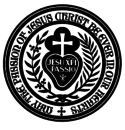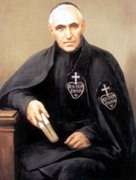Passionists
| Congregatio Passionis Iesu Christi | |
 | |
| Abbreviation | C.P. |
|---|---|
| Motto | May the Passion of Jesus Christ be always in our hearts |
| Formation | December 1720 |
| Founder | Saint Paul of the Cross |
| Type | Clerical Religious Congregation (Institute of Consecrated Life) |
| Purpose | Being awaken in the faithful the memory of the Passion of Christ and commended oneself in a special manner to him. |
| Headquarters | Piazza SS. Giovanni e Paolo, 13, 00184 Roma, Italia |
Membership (2013) | 2125 (of whom 1621 are priests) |
Superior General | Fr. Joachim Rego |
| Website |
passiochristi |
The Passionists (Latin: Congregatio Passionis Iesu Christi[1]) are a Roman Catholic religious institute founded by Saint Paul of the Cross with a special emphasis on the Passion of Jesus Christ. Professed members use the initials C.P. after their names. A known symbol of the congregation is the labeled emblem of the Sacred Heart of Jesus, surmounted by a cross and is often sewn into the clothing attire of its congregants.
History
St. Paul of the Cross wrote the rules of the Congregation in December 1720, and in 1725 Pope Benedict XIII granted Paul the permission to form his congregation. Paul and his brother, John Baptist, were ordained by the pope on the same occasion. The full canonical title of the congregation, following the revision of their Constitutions approved by the Holy See in 1984, is The Congregation of the Passion of Jesus Christ.[1][2]
After serving for a time in the hospital of St. Gallicano they left Rome with permission of the Pope and went to Mount Argentaro, where they established the first house of the institute. They took up their abode in a small hermitage near the summit of the mount, to which was attached a chapel dedicated to St. Anthony. They were soon joined by three companions, one of whom was a priest, and the observance of community life according to the rules began there and is continued there to the present day.[1]
In 1769, Clement XIV granted full rights to the Passionists as enjoyed by the other religious institutes, making them not an order but a congregation. The congregation historically has had two primary goals: missionary work and contemplative life, with an attempt to blend the two. Its founder had attempted to combine aspects of the contemplative orders, such as the Trappist monks, together with the dynamic orders, such as the Jesuits.
Charism
"We seek the unity of our lives and our apostolate in the Passion of Jesus." The Passionists express their participation in the Passion by a special vow, by which they bind themselves to keep alive the memory of the Passion of Christ. They strive to foster awareness of its meaning and value for each person and for the life of the world. They seek to incorporate this vow into our daily lives by living the evangelical counsels.[3]
Mission
"Our mission aims at evangelizing others by means of the Word of the Cross."[3]
Apostolate
Traditionally, their main apostolate has been preaching missions and retreats. According to Saint Paul of the Cross, they were founded in order to "teach people how to pray", which they do through activities such as retreats and missions, spiritual direction, and prayer groups. Today they often also assist local churches in pastoral works, including saying masses, hearing confessions, and visiting the sick. Due to the continuing shortage of priests in the United States, the Passionists today are sometimes designated as pastors and assistant pastors of various parishes. The Passionists staff many retreat centers around the world.
Unlike the La Sallians or the Gabrielites, Passionists do not usually open schools and universities, except seminaries for their own students wishing to become brothers and priests. There are some schools sponsored and run by the Passionists, like the St. Gemma Galgani School, (which includes primary, junior high and high school-level education) in Santiago (Chile), but these are more the exception than the rule. The Passionists are involved in social welfare projects and education mainly in the various mission territories assigned to them.
Though Passionists are not required to work in non-Christian areas as missionaries, their Rule allows its members to be posted to missionary work, such as mainland China (before the Communists took over in 1949), India, and Japan, and in many other nations in Africa, Asia, Latin America and elsewhere as dictated by the pope or at the invitation of a local Bishop.
There are 2,179 Passionists in 61 countries[3] on the five continents, led by a superior general who is elected every six years. He is assisted by six consultors in governing the congregation. The present superior general is Father Joachim Rego, who was born in Burma and with his family moved to Australia at an early age. The congregation is divided into provinces, vice-provinces and missions. The Congregation is also divided into groups of provinces, vice-provinces and missions called configurations. The presidents of the six configurations constitute the Extended General Council which meets with the Superior General and his consultors annually.[4]
There are six configurations in the world:[5]
- CEB: The Configuration of Eugene Bossilkov which includes Italy, France and Portugal and related mission territories. Since the I Chapter of 2015, this area is now the Province of Mary presented to the Temple;
- CCH: The Configuration of Charles Houben which includes Ireland, England, Scotland, Wales, Germany, Poland, Belgium, the Czech Republic, Ukraine, Holland, Sweden and related mission territories;
- CJC: The Configuration of Jesus Crucified which includes Mexico, Brazil, the United States, Argentina, Puerto Rico, the Dominican Republic, Haiti, Canada, Uruguay, Paraguay and related mission territories
- PASPAC: The Configuration of the Passionists in Asia Pacific which includes Australia, New Zealand, Papua New Guinea, the Philippines, Korea, Japan, Indonesia, India, China and Vietnam and related mission territories;
- CPA: The Configuration of the Passionists of Africa, which includes Kenya, Tanzania, the Republic of the Congo, South Africa, Botswana, Zambia and related mission territories;
- SCOR: The Configuration of the Sacred Heart which includes Spain, Peru, Colombia, Ecuador, Venezuela, Chile, Panama, Honduras, Guatemala, Cuba, El Salvador, Bolivia, Nicaragua and related mission territories.
The official name of the institute is "The Congregation of the Passion of Jesus Christ". The superior general resides in Rome (Piazza Ss. Giovanni e Paolo, 13, 00184 Roma; tel. 06 772711). The founder is buried in a chapel attached to the Basilica of Saints John and Paul, and the General Headquarters also hosts an international house of studies for Passionists from around the world.
Characteristics of the Congregation

The members of the congregation are not allowed to possess land, and the congregation collectively can only own the community house and a bit of land attached to it. They rely completely on their own labor and on contributions from the faithful in order to maintain themselves financially. The habit worn by members is a rough wool tunic bearing the words "Jesu XPI Passio", meaning "Passion of Jesus Christ" and the congregation was historically discalced, wearing sandals rather than shoes.
Canonised and beatified members
Canonised members of the Congregation
- Saint Paul of the Cross, founder of the congregation
- Saint Vincent Strambi, proto-bishop
- Saint Gabriel of Our Lady of Sorrows, student
- Saint Gemma Galgani, a lay Passionist;
- Saint Innocencio of Mary Immaculate, a martyr of the Spanish Civil War;
- Saint Charles of Mount Argus, a Dutchman who worked and died in Dublin; and
- Saint Maria Goretti is also considered a Passionist saint due to her Passionist spiritual directors.
Beatified members of the Congregation
- Blessed Eugene Bossilkov, Bulgarian Bishop and Martyr
- Blessed Lorenzo Maria of Saint Francis Xavier, Missionary
- Blessed Isidore of Saint Joseph; Lay Friar
- Blessed Dominic Barberi, notable for having received John Henry Newman into the Catholic faith;
- Blessed Bernard Mary of Jesus, co-founder of the congregation
- Blessed Grimoaldo of the Purification, student
- Blessed Pius of Saint Aloysius, student
- The twenty-six Catholic Martyrs of Daimiel.
In addition, the causes for the canonisation of Father Carl Schmitz, Father Ignatius Spencer, Father Theodore Foley and Elizabeth Prout have been opened.
Passionist Sisters
The Passionist Sisters (the Sisters of the Cross and Passion) is an institute founded in 1850 by Father Gaudentius Rossi, an early Passionist priest, as a convent for factory girls. In its infancy, it was called "Sisters of the Holy Family", and was later included under the Passionist family. Its first Mother Superior was Mother Mary Joseph Prout.
Due to their separate raisings guided by members of the congregation, Saints Maria Goretti and Gemma Galgani are traditionally counted in the ranks of the Passionists Sisters, even though they died before they could formally enter the institute (Maria was murdered, Gemma died of tuberculosis).
See also
-
 Spirituality portal
Spirituality portal - Chaplet of the Five Wounds
References
- 1 2 3 Devine, Arthur. "Passionists." The Catholic Encyclopedia. Vol. 11. New York: Robert Appleton Company, 1911. 17 Sept. 2014
- ↑ The Rule and Constitutions of the Congregation of the Passion of Jesus Christ: Rome, 1984; approved by the Holy See on 2 March 1984
- 1 2 3 Congregatio Passionis Jesu Christi
- ↑ The Statistics of the Congregation of the Passion of Jesus Christ: Passionist International Bulletin, Rome, Spring 2014
- ↑ The 2012 General Chapter of the Congregation of the Passion of Jesus Christ: Acts of the Chapter, Rome, 2013.
External links
| Wikisource has the text of the 1905 New International Encyclopedia article Passionists. |
| Wikimedia Commons has media related to Passionists. |
- International Website of the Passionists (English, Spanish, Italian)
- Passionists Australia, New Zealand and Papua New Guinea
- Passionists in the Philippines
- Passionists in Chile (Spanish, under construction)
- Passionists in France
- Website of the Sisters of the Cross and Passion
- Website of the Passionists of St. Paul of the Cross Province, North America
- Website of the Passionists of Holy Cross Province, North America
- Passionists in the U.K.
